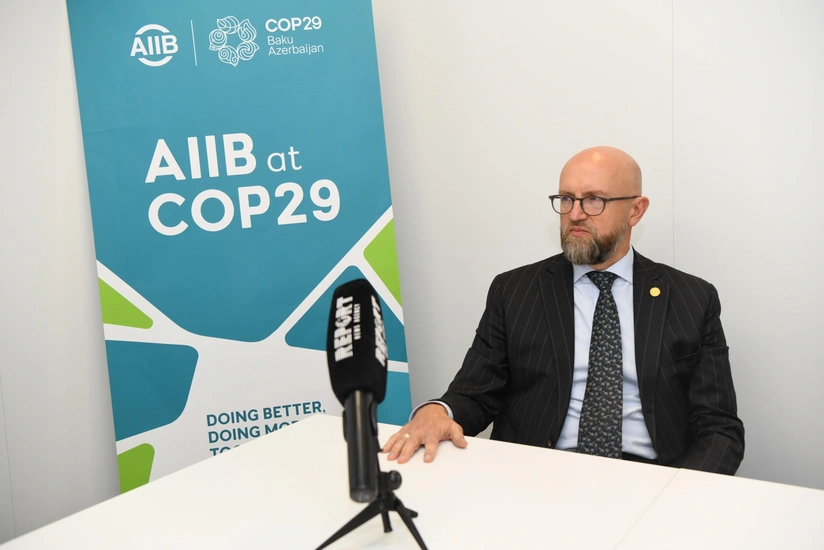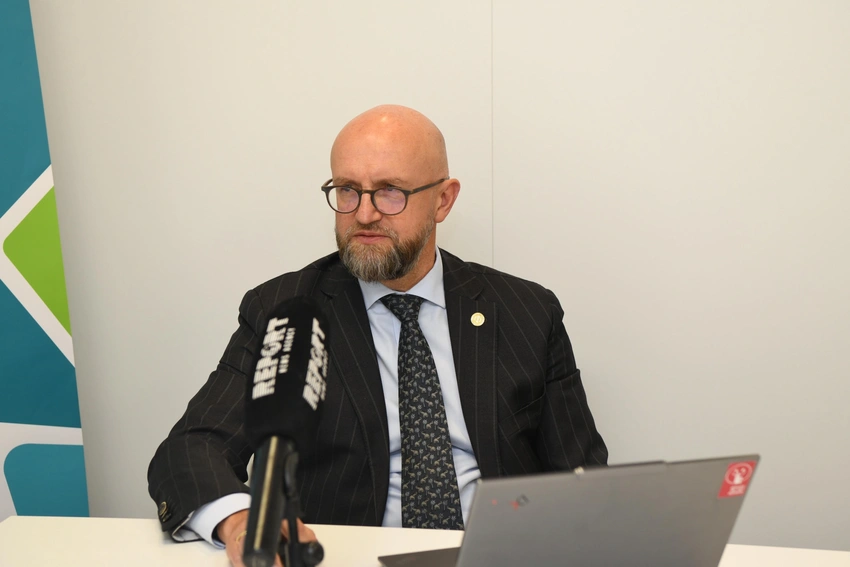Vice president: AIIB preparing to finance several solar, wind projects in Azerbaijan - INTERVIEW
- 18 November, 2024
- 06:31

The Asian Infrastructure Investment Bank (AIIB) has become a key player in financing sustainable projects across the region. Since its establishment in 2016, the bank has invested billions of dollars to support infrastructure development, including transportation, energy, water supply, and telecommunications.
Konstantin Limitovskiy, AIIB Vice President for Investment Clients Region 2 and Project and Corporate Finance, in an exclusive interview with Report, discussed the key areas of cooperation between the bank and Azerbaijan and other countries in the region, climate financing, and the role of infrastructure projects in achieving sustainable development goals.
1. Could you briefly describe the role of the Asian Infrastructure Investment Bank in developing infrastructure in the region and what goals the Bank pursues in its cooperation with member countries?
There is a huge multi-trillion-dollar infrastructure gap in Asia, especially in emerging market part of it. And Asian Infrastructure Investment Bank was established by 57 founding members to play a key role in financing this sustainable infrastructure across Asia, helping to bridge this funding gap, and boosting regional economic growth at the same time.
With a capital base of 100 billion dollars, AIIB funded about 55 billion of overall portfolio of which 45 billion dollars in infrastructure projects covering areas like transportation, energy, telecommunication, and water supply. This commitment highlights our strong dedication to sustainable infrastructure.
AIIB projects are aligned with the Paris Agreement and Sustainable Development Goals, with a focus on green and climate-friendly initiatives. Since last year, the share of our financing dedicated to climate projects exceeded 60%, and we are committed not to lower this down, not to lower this down, this share of it, to less than 50%.
Since the beginning, the Bank invested in Central Asia, in the Caucasus with over $5.5 billion in approved projects today in Uzbekistan, Kazakhstan, Tajikistan, Kyrgyzstan and the Caucasus. We also have a $4.5 billion project pipeline in these countries.

2. What priority areas of cooperation between AIIB and Azerbaijan would you highlight for the coming years? Could you elaborate on the most significant projects that AIIB is financing or planning to finance in Azerbaijan, and how they contribute to the country’s socio-economic development?
AIIB partnership with Azerbaijan started in the first year of our operations and we support the goals of Azerbaijan 2030 strategy, which focuses on sustainable and competitive growth. Key areas like transportation, energy and urban development are prioritized to promote economic diversification and long-term resilience of the economy.
Our major milestone in this collaboration was the AIIB financing of TANAP projects in 2016, the very first project of our operation, which boosted regional energy security and helped Turkiye and Europe during the 2022 energy crisis. Building on this foundation, AIIB is dedicated to supporting Azerbaijan's shift to renewable energy. For instance, at COP29, AIIB is finalizing financing for 760 megawatt Banka and Bilasuvar solar power project with an investment of 160 million dollars from our side. This project will increase renewable energy production and cut carbon dioxide emissions in the region.
Additionally, AIIB is preparing to finance several other solar and wind projects in the country. We are keen to collaborate more with the government of Azerbaijan, the other MDB partners, private sector partners, for our key area of infrastructure development of cross-border transportation, urban development, renewable energy, transmission line and the other projects.

3. What role does climate financing play in AIIB's activities, and how does the Bank support the transition to a green economy in the region?
Climate financing is the heart of the AIIB mission, especially in supporting the shift to a green economy across Asia and beyond. Our projects in Central Asia and South Caucasus reflect this, our commitment. In Kazakhstan, we lead financing in wind power. In Tajikistan, we focus on hydropower and in Uzbekistan, we partner with our Middle Eastern clients on the region’s largest solar portfolio so far.
Recognizing the role of governments and importance of reforms and right policy frameworks for quick and efficient implementation of climate strategies, AIIB opened the climate focused policy-based financing window this year. This financing plays a vital role in helping member countries implement policy changes that boost climate finance, mobilize private sector capital, and support the move to a low-carbon, climate resilient economy.
This approach is climate focused, enabling us to provide customized services or team up with the development banks to raise additional resources. These initiatives do strengthen our long-term partnership and advance of our infrastructure for tomorrow strategy, which targets economically viable, climate resilient projects in areas like water, urban development and renewable energy.
The AIIB goal is to approve $50 billion dollars in climate financing by 2030, reinforcing our commitment to sustainable development.

4. What sustainability criteria does AIIB consider when evaluating and financing projects, and how does the Bank contribute to achieving sustainable development goals in member countries?
This is also a very important question. AIIB follows strict sustainability standards in evaluating projects meet high environmental and social benchmarks aligned with the sustainable development goals for each country. Guided by this environmental and social framework, AIIB manages project risks throughout the cycle, applying mandatory environmental and social standards. Each project we finance undergoes a thorough assessment based on OECD criteria, including relevance, effectiveness, efficiency, impact, sustainability, and coherence.
To guarantee long-term benefits, AIIB green infrastructure projects promote sustainable cities, clean water and affordable energy, such as our renewable projects in Azerbaijan, which we are planning and preparing to sign during this COP29, which supports sustainable development goals on clean energy and sustainable communities.
5. How does AIIB promote regional integration and infrastructure cooperation, and what projects are being implemented under these regional initiatives? Specifically, does the Bank plan to support infrastructure expansion along the Middle Corridor, and what challenges face regional infrastructure cooperation that AIIB can help address?
As I discussed a little bit before, AIIB prioritizes infrastructure projects that boost regional integration, aiming to improve cross-border connectivity, trade, and economic growth. By 2030, AIIB plans that cross-border connectivity projects would account for 25- 30 percent of its financing portfolio, showing our dedication to strengthening and economic links across the region.

By the way, TANAP in Azerbaijan is one of the good examples which enhances energy cooperation, energy security and transit. Middle corridor connecting Asia to Europe through Azerbaijan, Georgia and Turkiye is a very important program for us. AIIB plans to invest in expanding infrastructure along this route, including railways, roads, ports, and logistics centers to make this road and train along this more efficient.
To address issues like connectivity gaps and funding limitations, AIIB provides targeted financing, technical assistance, and a variety of supports for regional dialogue, helping member countries to align and strengthen their infrastructure network.
